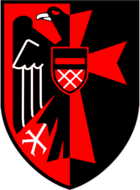
Back ألمان السوديت Arabic Sudetndeitsche BAR Судэцкія немцы Byelorussian Судэцкія немцы BE-X-OLD Sudetští Němci Czech Sudetertysker Danish Sudetendeutsche German Sudetgermanoj Esperanto Alemanes de los Sudetes Spanish Allemands des Sudètes French
Sudetendeutsche | |
|---|---|
 | |
 Flag of the Sudeten Germans and the coat of arms of the Sudeten German Homeland Association | |
| Total population | |
| c. 3,252,000 in 1910 39,106 in 2001 | |
| Regions with significant populations | |
| Bohemia, Moravia and Czech Silesia. Many of them also live in Germany and Austria, as well in Slovakia. | |
| Languages | |
| German, Czech | |
| Religion | |
| Roman Catholic majority Lutheran Protestant minority | |
| Related ethnic groups | |
| Germans, Austrians and Czechs |
German Bohemians (German: Deutschböhmen und Deutschmährer [ˈdɔʏtʃˌbøːmən] ⓘ; Czech: čeští Němci a moravští Němci, lit. 'German Bohemians and German Moravians'), later known as Sudeten Germans (German: Sudetendeutsche [zuˈdeːtn̩ˌdɔʏtʃə] ⓘ; Czech: sudetští Němci), were ethnic Germans living in the Czech lands of the Bohemian Crown, which later became an integral part of Czechoslovakia. Before 1945, over three million German Bohemians constituted[1] about 23% of the population of the whole country and about 29.5% of the population of Bohemia and Moravia.[2] Ethnic Germans migrated into the Kingdom of Bohemia, an electoral territory of the Holy Roman Empire, from the 11th century, mostly in the border regions of what was later called the "Sudetenland", which was named after the Sudeten Mountains.[3]
The process of German expansion was known as Ostsiedlung ("Settling of the East"). The name "Sudeten Germans" was adopted during rising nationalism after the fall of Austria-Hungary after the First World War. After the Munich Agreement, the so-called Sudetenland became part of Germany.
After the Second World War, most of the German-speaking population (mostly Roman Catholic with relatively few Protestants) was expelled from Czechoslovakia to Germany and Austria.
The area that became known as the Sudetenland possessed chemical works and lignite mines as well as textile, china, and glass factories. The Bohemian border with Bavaria was inhabited primarily by Germans. The Upper Palatine Forest, which extends along the Bavarian frontier and into the agricultural areas of southern Bohemia, was an area of German settlement. Moravia contained patches of "locked" German territory to the north and south. More characteristic were the German language islands, which were towns inhabited by German minorities and surrounded by Czechs. Sudeten Germans were mostly Roman Catholics, a legacy of centuries of Austrian Habsburg rule.
Not all ethnic Germans lived in isolated and well-defined areas; for historical reasons, Czechs and Germans mixed in many places, and Czech-German bilingualism and code-switching was quite common. Nevertheless, during the second half of the 19th century, Czechs and Germans began to create separate cultural, educational, political and economic institutions, which kept both groups semi-isolated from each other, which continued until the end of the Second World War, when almost all the ethnic Germans were expelled.

- ^ "Expellee 'Provocation': Prague Refuses Apology to Sudeten Germans". Der Spiegel. June 14, 2011.
- ^ "Czech Statistical Office". Archived from the original on 2013-12-03. Retrieved 2011-08-09.
- ^ Otto Bauer. The Question of Nationalities and Social Democracy (Minneapolis: University of Minnesota press, 2000), p. 160
- ^ Statistický lexikon obcí v Republice československé I. Země česká. Prague. 1934.
{{cite book}}: CS1 maint: location missing publisher (link)
Statistický lexikon obcí v Republice československé II. Země moravskoslezská. Prague. 1935.{{cite book}}: CS1 maint: location missing publisher (link)